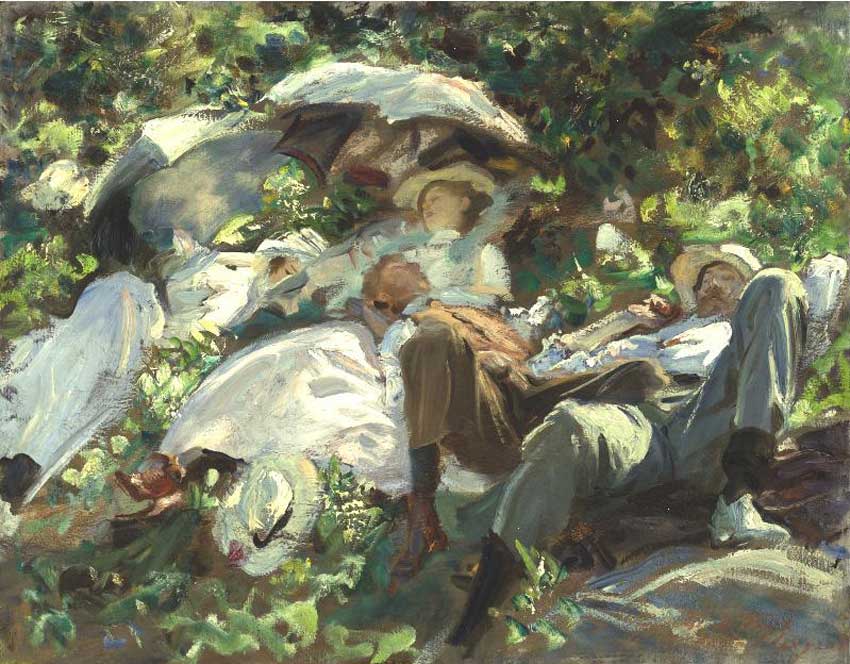Group with
Parasols
John Singer
Sargent
-- American painter
c. 1905
Collection
of Rita and
Daniel Fraad
Oil on canvas
55.2 x 70.8
cm (21 3/4
x 27 7/8 in.)
inscribed
to my friend Ginx and
signed John S. Sargent, l.r.
Jpg:
local/ Sothebys
Painting of Peter
Harrison and his
brother Ginx Harrison with two women, possibly Dos
Palmer and Lillian Mellor.
Giovanni
Boldini (1845 -1931)
Italian-French
portrait painter

Portrait
of the Artist: Lawrence Alexander "Peter" Harrison
From: Sothebys
The 1905 trip to Giomein included Peter Harrison, his brother Leonard
“Ginx” Harrison, Alma Strettell (Peter’s wife), Dos Palmer (Peter’s
mistress), Polly Barnard and Lillian Mellor. Sargent routinely spent
the days in the countryside painting under the shade of large white
umbrellas and in the evenings, enjoyed music, chess and reading with
his entourage. Sargent’s group frequently modeled for him on his
sketching expeditions, and he enjoyed painting them in their idle
moments of repose. Mr. Ormond notes, “Sargent’s pictures of sleeping
and resting figures, which are such a feature of his Alpine output over
a ten year period, conjure up an imaginary world of luxuriant ease and
passive indolence. They are not a record of how the Sargent party spent
their time in the mountains (active expeditions were the order of the
day), but a deliberately invented world of dreamy reverie” (John Singer
Sargent, Princeton, New Jersey, 1998, p. 244).
Group with Parasols (A
Siesta) is a beautiful example of the ‘world of
dreamy reverie’ and is evocative of the newfound intimacy in Sargent’s
work. The painting captures the Harrison brothers Peter and Ginx, Dos
Palmer and Lillian Mellor enjoying a mid-afternoon slumber amid the
grassy hills of the region. The closeness of the figures, the fluid
intertwining of limbs and the juxtaposition of male and female
represents an unusual familiarity between the sexes that would have
challenged Victorian convention. Mr. Ormond writes, “There is a
deliberate contrast between the two sides of the composition, softly
rounded contours and delicate materials for the women, angular knees,
elbows and creased trousers for the men. At the same time the rhythm of
the curving bodies, arms, and heads unites the figures in a tightly
interlocking group” (John Singer Sargent, p. 244). Ilene Susan Fort
notes that the Alpine Pictures “display contradictions in time, gender
orientation, and degree of sexuality that can be understood only within
the social context of the age. Sargent was a personality not only
aesthetically progressive but also socially bohemian; his opinions and
taste were sometimes at odds with, and too modern for, the strictest
Victorian society” (Sargent in Italy, Princeton, New Jersey, 2003, p.
142).
The intimacy of the subjects
is further emphasized by the essentially
closed composition in which the surrounding landscape is closely
cropped and bordered. Ms. Fort observes, “Sargent placed his models in
an intimate and virtually anonymous outdoor environment, thereby
creating the notion of a ‘landscape interior.’ He repeatedly depicted a
small forest glade that marked the boundaries of his personal domain.
By cropping and deleting horizons, Sargent made the landscape appear to
be pushed forward, parallel to the picture plane. His models exist in
this limited space with no suggestion of a world beyond the painted
scene” (Sargent in Italy, p. 148). The intimate subject and setting of
Group with Parasols (A Siesta) was revisited in several watercolors of
the period, including the strikingly similar Siesta, also of 1905
(figure 1) and Simplon Pass: The Green Parasol (figure 2).
A strong component of the
unusual visual effects the painting produces
lies in Sargent’s treatment of the picture's surface, its heavy
application and active handling of paint create a richly patterned
composition punctuated by highlights of dappled light and sunlit
passages. Mr. Ormond writes, “The brushwork has a dynamic energy and a
life of its own so that the picture could be read as blocks of colour
or patterns of light and dark, independent of the forms which they
describe. This is where the modernity of Sargent’s vision lies, in the
suppression of detail, and in the concentration on surface texture and
expressive brushstroke” (Richard Ormond, John Singer Sargent, p. 244).
Ms. Fort writes, “The Alpine
paintings sit outside Sargent’s usual
work, evincing neither the painterly academism of his portraits nor the
full Impressionism of his landscape and figure paintings created in
Broadway, England…The Alpine works as a whole do evince a new, more
progressive boldness, particularly in design, that demonstrates a
daring level of experimentation.” (Sargent in Italy, p. 141) Group with
Parasols (A Siesta) is at once the artistic embodiment of Sargent’s
daring style, conjuring the pictorial effects of light and shadow for
which he is so well known, and a uniquely compelling and intimate look
into the artist’s inner circle.]
(Sothebys)
Note:
Bibliography
Evan Charteris, John Sargent, New York, 1927, p. 295
David McKibbin,
Sargent’s Boston: with an Essay & a Biographical Summary & a
complete Check List of Sargent’s Portraits, Boston, Massachusetts,
1956, p. 100
Charles Merrill
Mount, John Singer Sargent: A Biography, New York, 1955, no. K 1216, p.
451
Richard Ormond,
John Singer Sargent: Paintings, Drawings & Watercolors, New York,
1970, p. 75
James Lomax and
Richard Ormond, John Singer Sargent and the Edwardian Age, London,
1979, p. 97
John Singer
Sargent, New York, Whitney Museum of American Art, 1986, illustrated in
color p. 203, fig. 162
Doreen Bolger
and
Nicolai Cikovsky, Jr., eds., American Art Around 1900: Lectures in
Memory of Daniel Fraad, Hanover, New Hampshire, 1990, pp. 29-39,
illustrated in color p. 28 (detail), illustrated p. 40
Warren Adelson,
Donna
Seldin Janis, Elaine Kilmurray, Richard Ormond and Elizabeth Oustinoff,
Sargent Abroad: Figures and Landscapes, New York, 1997, pp. 54, 80,
illustrated in color p. 81
Sargent and
Italy, Los Angeles, California, Los Angeles County Museum of Art, 2003,
p. 154, illustrated in color pp. 150-51
Exhibitions
London, England,
Royal Academy of Arts, Exhibition of the Works of the Late John S.
Sargent, R.A., Winter 1926, no. 3
(possibly)
London, England, Royal Academy of Arts, British Paintings since
Whistler, 1940, no. 460
Brooklyn, New
York, The Brooklyn Museum; Addison Gallery of American
Art, Andover, Massachusetts, Phillips Academy, American Painting:
Selections from the Collection of Daniel and Rita Fraad, June-November
1964, no. 30, p. 38, illustrated in color, also illustrated in color on
the cover
New York,
Whitney Museum of American Art, Art of the United States:
1670-1966, September-November 1966, no. 246, pp. 69, 153, illustrated
p. 69
New York, The
Metropolitan Museum of Art, 100th Anniversary of Impressionism,
December 1974-February 1975
Fort Worth,
Texas, Amon Carter Museum, American Paintings, Watercolors,
and Drawings from the Collection of Rita and Daniel Fraad, May-July
1985, no. 15, pp. 34-6, illustrated in color p. 35
London, England,
The Tate Gallery; Washington, D.C., The National
Gallery of Art; Boston, Massachusetts, Museum of Fine Arts, John Singer
Sargent, October 1998-September 1999, no. 135, pp. 221, 244,
illustrated p. 245
Provenance
Sale: Christie, Manson & Woods, London, England, Pictures and Water
Colour Drawings by J.S. Sargent, R.A. and Works by Other Artists, July
27, 1925, lot 194
Leonard Fred
Harrison, London, England, 1926
Wilfred G. de Glehn, London, England
A. Richards, London (sold: Sotheby & Co., London, England, December
13, 1961, lot 128)
John Nicholson
Gallery, New York (acquired at the above sale)
Hirschl &
Adler Galleries, New York
Acquired by Rita and Daniel Fraad from the above, 1962
Sale
Sold Sothebys,
December 1, 2004, Sale N08032, Lot 7, $23,528,000 USDHammer Price with
Buyer's Premium, was estimated 9,000,000
--
12,000,000 USD
Painting is dated
c. 1905
by Adelson
Galleries, dated c. 1908-11 by Patricia Hill's book and Sothebys
|






